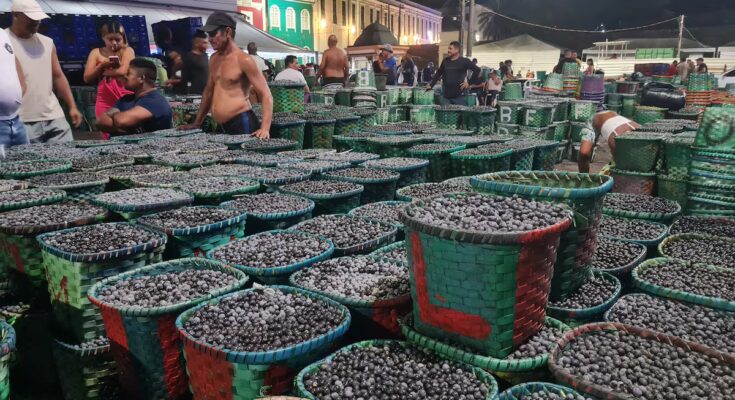Every night, the port of Belém, in the heart of the Brazilian Amazon, transforms into a lively purple-hued market. It is the color of açaí, the fruit of a tropical palm tree which in recent years has become fashionable throughout the world due to its high nutritional value. The boats crossed the waters of the Amazon River estuary filled with baskets overflowing with the fruits harvested that same day. When night falls, once on the ground, you have to hurry, because the fruit does not tolerate the heat well, it must reach the plants that process it as soon as possible. At the dock, the baskets will be sold to middlemen, loaded onto trucks and a successful journey not without its challenges will begin. It already moves 5 billion reais (more than 900 million dollars) a year. The danger now is not dying of success.
Bioeconomy businesses and their challenges – for example, how to grow açai sustainably, without deforestation – are one of the issues discussed in parallel events at COP30, the annual UN climate conference, which begins this Monday in Belém. Same pavilion, but separate. While NGOs present their complaints and demands, and companies boast about their green efforts, in closed rooms thousands of delegates from more than 140 governments around the world will negotiate the next steps in the fight against global warming until the 21st, a battle that the Trumpist denier threatens.
Since the world has known the charm of açaí, the price paid for the baskets in the port of Belém has not stopped increasing. In the last 20 years it has grown by 2,900%. The immediate effect was predictable: the cultivation of açaí palms on a piece-rate basis, often to the detriment of native flora. Today, 1.7 million tons are harvested per year, almost 20 times more than in the 1990s. Almost everything comes from the state of Pará. Now, a government body, the Brazilian Agriculture and Livestock Company (Embrapa in its Portuguese acronym), promotes a sustainable management method that ensures long-term survival and also increases productivity. The economic boom goes hand in hand with a cultural revolution.
The truth is that until not long ago eating açaí was “something for poor people”. Says Nazareno Alves, who today manages the Point do Açaí restaurant, an obligatory stop in Belém. “When I was little, rich people ate açaí secretly, because of the pigmentation it leaves in the mouth,” he recalls during a trip to Pará organized by Embrapa. Alves, from humble origins, says açaí has transformed his life. He now has several restaurants, chairs the industry’s main association and holds conferences throughout northern Brazil.
The indigenous people, of course, have known about açaí since time immemorial. Today it is eaten here for breakfast, lunch and dinner. It’s like rice or bread in other cultures: essential. There is no Paraense without its açaí bowl with cassava flour to accompany the fried fish. At six months, babies basically switch from breast milk to açaí, thanks to its mushy consistency. Açaí in Pará is a religion, especially pure açaí, freshly beaten and without the sugar or guarana that are added when it leaves this corner of Brazil. Some is exported, especially to Europe and the United States, but 75% of the açaí harvested remains in Pará. Producers keep a portion for their own consumption and sell the rest.
The problem now is prices, especially outside the harvest season. Açaí is mainly harvested between November and January. Then production drops dramatically and prices skyrocket. Between April and June there are problems of food insecurity due to the lack of açaí, they tell Embrapa. This dependence is seen above all in the producing populations, in the communities ribeirinhas from the island of Marajó.

This huge island in the Amazon estuary (it is the size of Holland) concentrates most of the açaizeiros from Brazil. Palm trees are easy to recognize: thin trunks and thin, light leaves that move like pennants in the wind. They grow spontaneously on the banks (of the Amazon River and all its branches, tributaries, canals and other rivers). 20% of the planet’s fresh water passes through here. The encounter with the ocean is fundamental for the palm, because it generates tides that cause the level to rise and fall by more than a meter several times a day. With every flood comes sediment loaded with nutrients.
This movement of the waters is easily observable from the wooden pier of the house of Arcindo Moraes da Silva and Maria de Jesus Coelho da Silva. The Silvas were pioneers in growing açaí sustainably. Until ten years ago they killed the rest of the species and multiplied them açaizeiros. It seemed logical: more palm trees, more açaí. Hand.
Embrapa studies have found that the palm performs better when surrounded by other species, because these provide more leaves (organic matter, fertilizer), especially legumes, which inject nitrogen into the soil. Furthermore, since each tree flowers at a certain time, bees survive all year round. With more bees, more pollination, more açaí. In theory it all sounded very nice, but applying it wasn’t easy. Arcindo had to uproot many palm trees and let the jungle take over a small part of his land. The result took a little time, but it was worth it. “Before I collected around 500 baskets a year, now around 2,500. Before this system we only harvested in the summer months, then there was nothing. To survive we had to dedicate ourselves to fishing”, he says. Part of its production is purchased by the Government to supply school canteens in the area in the season when it is most difficult to find (and pay for) açaí.

The Silvas, like almost everyone in this region, are a very humble family. Until last year they had no electricity. Now the administration of Luiz Inácio Lula da Silva and his Light for All program have installed a solar panel, something that, together with the açaí boom, has radically changed their lives. They finally have some savings, a fridge, a washing machine and are building a three-storey house in Muaná, the nearest town.
Not far from the Silvas’ home, another neighbor, Miguel Cardoso de Souza, has already replicated the system. “People said: Arcindo is crazy, he will take açaizal. At the beginning we had doubts, because it takes three years to produce results, that’s why many people were wary”, he confesses. Now he is one of those who sings about the benefits of the agroforestry system. He also has several hives of bees that until recently he fought as if they were the enemy to be defeated.
Açaí is a fruit, as they say in Brazil, abençoado (blessed). The palm grows very quickly and no pesticides are used because they are not necessary, no parasite has ever been detected. Specialists attribute the fruit’s natural resistance to the delicate balance of the jungle. On the other hand, the palm tree doesn’t make things easier. To harvest açaí you have to go up the trunk to the bunches. It’s not suitable for everyone, you need to be fit and, if possible, slim. Arcindo says this with satisfaction after going up to cut some bunches. An up and down of less than a minute. Here is another key to access the world of the palm tree. There is a labor shortage and child labor is not uncommon. The youngest in the family is often used. There are prototypes of machines and robots, but so far nothing that has given an acceptable and convenient result.

Everything is still very artisanal, but the revolution is underway. Açaí in Brazil currently occupies approximately 265,000 hectares and the surface area is expected to double. In recent years, Embrapa has developed seeds suitable for cultivation on land, which relieve some of the pressure on riverine forests and make it possible to grow açaí on degraded lands or until now dedicated to livestock, even in other areas of Brazil. Specialists assure that to continue exporting açaí to the world it will not be necessary to raze the jungle to the ground. And they also warn: açaí is just one example of everything the Amazon can bring to the local economy if done carefully. The list of fruits that go hand in hand with sustainable development is long: from cocoa and the Brazilian chestnut to others less known, such as copaíba, andiroba, bacuri or cupuaçú.



